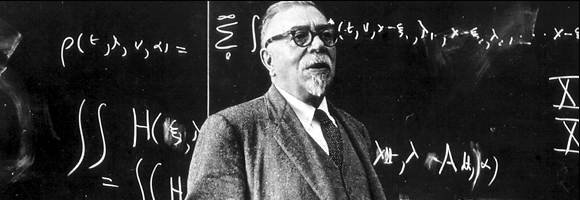cybernetics

Cybernetics was defined by Norbert Wiener [see picture above] as ‘the science of control and communication, in the animal and the machine’ [↵Wiener 1948]—in a word, as the art of steermanship, and it is to this aspect that the book will be addressed. Co-ordination, regulation and control will be its themes, for these are of the greatest biological and practical interest. (↵Ashby 1957[1956]:1)
Additionally a slightly longer quotation from a more recent article:
Derived from the Greek kybernetes, or “steersman”, the term “cybernetics” first appears in Antiquity with Plato, and in the 19th century with Ampère, who both saw it as the science of effective government. The concept was revived and elaborated by the mathematician Norbert Wiener in his seminal 1948 book, whose title defined it as “Cybernetics, or the study of control and communication in the animal and the machine”. Inspired by wartime and pre-war results in mechanical control systems such as servomechanisms and artillery targeting systems, and the contemporaneous development of a mathematical theory of communication (or information) by Claude Shannon, Wiener set out to develop a general theory of organizational and control relations in systems.
Information Theory, Control Theory and Control Systems Engineering have since developed into independent disciplines. What distinguishes cybernetics is its emphasis on control and communication not only in engineered, artificial systems, but also in evolved, natural systems such as organisms and societies, which set their own goals, rather than being controlled by their creators.
Cybernetics as a specific field grew out of a series of interdisciplinary meetings held from 1944 to 1953 that brought together a number of noted post-war intellectuals, including Wiener, John von Neumann, Warren McCulloch, Claude Shannon, Heinz von Foerster, W. Ross Ashby, Gregory Bateson and Margaret Mead. Hosted by the Josiah Macy Jr. Foundation, these became known as the Macy Conferences on Cybernetics. From its original focus on machines and animals, cybernetics quickly broadened to encompass minds (e.g. in the work of Bateson and Ashby) and social systems (e.g. Stafford Beer’s management cybernetics), thus recovering Plato’s original focus on the control relations in society. (↵Heylighen & Joslyn 2001:2) [italics emphasis’ added by me]
For those who want to have everything in a nutshell: ↵Joslyn & Heylighen 1999 is an earlier and shorter version of the encyclopedia-article quoted above, minus the second-order cybernetics. But if the contents of the nutshell are not enough, the ↑Principia Cybernetica Web, of which ↑Francis Heylighen and ↑Cliff ↑Joslyn are founding members, carries enough to drive you mad instantaneously.

